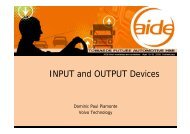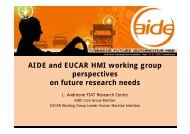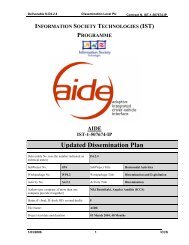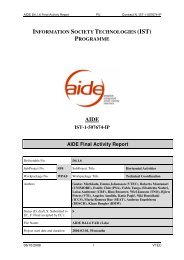- Page 1 and 2: Deliverable D4.2.1 Dissemination Le
- Page 3 and 4: Deliverable D4.2.1 Dissemination Le
- Page 5 and 6: Deliverable D4.2.1 Dissemination Le
- Page 7 and 8: Deliverable D4.2.1 Dissemination Le
- Page 9 and 10: Deliverable D4.2.1 Dissemination Le
- Page 11 and 12: Deliverable D4.2.1 Dissemination Le
- Page 13 and 14: Deliverable D4.2.1 Dissemination Le
- Page 15 and 16: Deliverable D4.2.1 Dissemination Le
- Page 17 and 18: Deliverable D4.2.1 Dissemination Le
- Page 19 and 20: Deliverable D4.2.1 Dissemination Le
- Page 21 and 22: Deliverable D4.2.1 Dissemination Le
- Page 23: Deliverable D4.2.1 Dissemination Le
- Page 27 and 28: Deliverable D4.2.1 Dissemination Le
- Page 29 and 30: Deliverable D4.2.1 Dissemination Le
- Page 31 and 32: Deliverable D4.2.1 Dissemination Le
- Page 33 and 34: Deliverable D4.2.1 Dissemination Le
- Page 35 and 36: Deliverable D4.2.1 Dissemination Le
- Page 37 and 38: Deliverable D4.2.1 Dissemination Le
- Page 39 and 40: Deliverable D4.2.1 Dissemination Le
- Page 41 and 42: Deliverable D4.2.1 Dissemination Le
- Page 43 and 44: Deliverable D4.2.1 Dissemination Le
- Page 45 and 46: Deliverable D4.2.1 Dissemination Le
- Page 47 and 48: Deliverable D4.2.1 Dissemination Le
- Page 49 and 50: Deliverable D4.2.1 Dissemination Le
- Page 51 and 52: Deliverable D4.2.1 Dissemination Le
- Page 53 and 54: Deliverable D4.2.1 Dissemination Le
- Page 55 and 56: Deliverable D4.2.1 Dissemination Le
- Page 57 and 58: Deliverable D4.2.1 Dissemination Le
- Page 59 and 60: Deliverable D4.2.1 Dissemination Le
- Page 61 and 62: Deliverable D4.2.1 Dissemination Le
- Page 63 and 64: Deliverable D4.2.1 Dissemination Le
- Page 65 and 66: Deliverable D4.2.1 Dissemination Le
- Page 67 and 68: AIDE User Forum Workshop logo Works
- Page 69 and 70: AIDE User Forum Workshop logo AIDE
- Page 71 and 72: AIDE User Forum Workshop logo Works
- Page 73 and 74: AIDE User Forum Workshop logo 14:30
- Page 75 and 76:
AIDE User Forum Workshop logo Wedne
- Page 77 and 78:
AIDE User Forum Workshop logo Parti
- Page 79 and 80:
AIDE IP logo The AIDE (Adaptive Int
- Page 81 and 82:
AIDE IP logo AIDE Partners Industry
- Page 83 and 84:
AIDE IP logo HMI Integration Key is
- Page 85 and 86:
AIDE IP logo Realising the AIDE vis
- Page 87 and 88:
AIDE IP logo Examples of ongoing wo
- Page 89 and 90:
AIDE IP logo Examples of work: Work
- Page 91 and 92:
AIDE IP logo Real-time DVE monitori
- Page 93 and 94:
AIDE IP logo Interaction with other
- Page 95 and 96:
AIDE IP logo Conclusions • The AI
- Page 97 and 98:
AIDE IP logo Design Scenarios and H
- Page 99 and 100:
AIDE IP logo Idea : Suitable Manage
- Page 101 and 102:
AIDE IP logo Derive Use Cases & Sce
- Page 103 and 104:
AIDE IP logo Action Categorization
- Page 105 and 106:
AIDE IP logo Action Categorization
- Page 107 and 108:
AIDE IP logo Action Categorization
- Page 109 and 110:
AIDE IP logo Scenario Description (
- Page 111 and 112:
AIDE IP logo Outlook • Use of cat
- Page 113 and 114:
AIDE IP logo Evaluation of Adaptive
- Page 115 and 116:
AIDE IP logo Early Integration of A
- Page 117 and 118:
AIDE IP logo Actual Status of Integ
- Page 119 and 120:
AIDE IP logo Future Integration of
- Page 121 and 122:
AIDE IP logo Adaptivity - Types, Ap
- Page 123 and 124:
AIDE IP logo Evaluation - State of
- Page 125 and 126:
AIDE IP logo Development of Methodo
- Page 127 and 128:
Deliverable D4.2.1 Dissemination Le
- Page 129 and 130:
AIDE IP logo Modelling objectives
- Page 131 and 132:
AIDE IP logo Driver - Vehicle - Env
- Page 133 and 134:
AIDE IP logo Interface Adaptation V
- Page 135 and 136:
AIDE IP logo MODELLING (Theories an
- Page 137 and 138:
AIDE IP logo MODELLING (Theories an
- Page 139 and 140:
MODELLING (Theories and paradigms)
- Page 141 and 142:
AIDE IP logo EXPERIMENTS (Parameter
- Page 143 and 144:
AIDE IP logo EXPERIMENTS (Parameter
- Page 145 and 146:
Harmonized Standards and Research f
- Page 147 and 148:
Ergonomics and Crash Avoidance Divi
- Page 149 and 150:
Assessing Multifunction Devices In-
- Page 151 and 152:
Multifunction Devices: Conclusions
- Page 153 and 154:
9 (Mattes, 2003) 9
- Page 155 and 156:
0.8 Mean deviation per task perform
- Page 157 and 158:
Alliance of Automobile Manufacturer
- Page 159 and 160:
TC Assessment of the AAM Statement
- Page 161 and 162:
Memorandum of Understanding (MOU) o
- Page 163 and 164:
MOU Part 1: Guidelines for Limiting
- Page 165 and 166:
MOU Part 2: Recommended Safety Desi
- Page 167 and 168:
General requirements…continued
- Page 169 and 170:
Considerations for Adaptive HMI: Au
- Page 171 and 172:
Considerations for Adaptive HMI: Us
- Page 173 and 174:
AIDE User Forum Workshop “Develop
- Page 175 and 176:
Competition for Drivers Attention
- Page 177 and 178:
A Cognitive Example: Embedded Video
- Page 179 and 180:
Driver Distraction Sources and Impa
- Page 181 and 182:
Our Agenda • Review Driver Distra
- Page 183 and 184:
Typical Approach - Embedded in a Ve
- Page 185 and 186:
Workload Manager Types Type Example
- Page 187 and 188:
Our Agenda • Review Driver Distra
- Page 189 and 190:
Driver Advocate • A driver assist
- Page 191 and 192:
Goals of the System • Generation
- Page 193 and 194:
Intelligent System Technology Pyram
- Page 195 and 196:
Generation Two and Three Experience
- Page 197 and 198:
Seamless Mobility - The future of C
- Page 199 and 200:
Seamless Mobility: the Car is Conne
- Page 201 and 202:
Seamless Mobility Technology - Addr
- Page 203 and 204:
References • Green, P. (2004). Dr
- Page 205 and 206:
Measures of Driver Distraction •
- Page 207 and 208:
Deliverable D4.2.1 Dissemination Le
- Page 209 and 210:
AIDE User Forum Workshop logo ROUND
- Page 211 and 212:
AIDE SP3 NOMADIC DEVICE WORKSHOP -
- Page 213 and 214:
AIDE SP3 1 st European Nomadic Devi
- Page 215 and 216:
AIDE SP3 Nomad Devices : Integratio
- Page 217 and 218:
AIDE SP3 Towards a Solution - Curre
- Page 219 and 220:
AIDE SP3 Towards a Solution Standar
- Page 221 and 222:
AIDE SP3 INTEGRATION ISSUES - ELECT
- Page 223 and 224:
AIDE SP3 INTEGRATION ISSUES - PROTO
- Page 225 and 226:
AIDE SP3 Thank You Patrick Robertso
- Page 227 and 228:
Deliverable D4.2.1 Dissemination Le
- Page 229 and 230:
AIDE IP Overview • What is Behavi
- Page 231 and 232:
AIDE IP New systems and behavioural
- Page 233 and 234:
AIDE IP Behavioural Adaptation Seve
- Page 235 and 236:
AIDE IP Behavioural Adaptation in A
- Page 237 and 238:
AIDE IP Research studies • Impact
- Page 239 and 240:
AIDE IP The importance of the situa
- Page 241 and 242:
AIDE IP The differential impact of
- Page 243 and 244:
AIDE IP Further research on Behavio
- Page 245 and 246:
AIDE IP Research activities within
- Page 247 and 248:
AIDE IP The temporal conditions Lea







